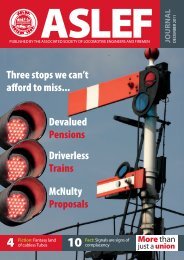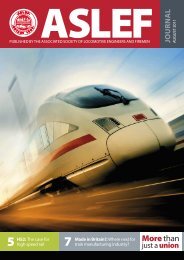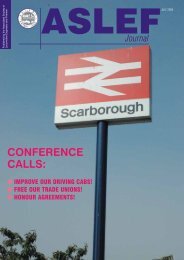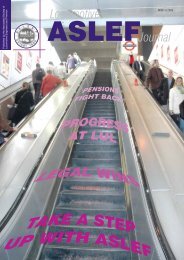Create successful ePaper yourself
Turn your PDF publications into a flip-book with our unique Google optimized e-Paper software.
12 Signals<br />
The ASLEF JOuRNAL<br />
RECENT EVENTS SIGNAL A LACK OF SAFETY CONCERN<br />
LAST month a report was issued about an incident at<br />
Moreton-on-Lugg near Hereford. Why was it significant<br />
Because it showed that in some places on our railways we<br />
still have sub-Victorian signalling systems – which is a<br />
scandal in our fast speed, high tech, technology-rich<br />
society.<br />
Meanwhile less than 100 miles from Moreton, at<br />
Machynlleth, our members are supposed to be testing the<br />
state-of-the-art European Railway Traffic Management<br />
System (ERTMS). They are doing their best, as we report<br />
below – but under trying circumstances which is making<br />
progress slower than a Victorian hansom cab.<br />
A safe signalling system is a prerequisite for a safe<br />
railway – and unless passengers have utter confidence in<br />
safety, all the other initiatives and investments are utterly<br />
pointless. Signals are serious. We need to be serious<br />
about them.<br />
Keith Norman, General Secretary<br />
VICTORIAN SIGNALS BEHIND<br />
MORETON CROSSING TRAGEDY<br />
L<br />
AST month a woman was killed when<br />
her car was hit by a train on a level<br />
crossing in Herefordshire. Jane<br />
Harding, 52, died on the crossing near the<br />
village of Moreton-on-Lugg. The level crossing<br />
has barriers and lights and there is a signal box<br />
nearby.<br />
The first report from Network Rail discovered<br />
that, ‘The signalling and level crossing controls<br />
at Moreton-on-Lugg do not have any form of<br />
approach locking, allowing the level crossing<br />
barriers to be raised immediately after the<br />
signals are replaced to danger and even with a<br />
train approaching.’<br />
What does this mean for train drivers and for<br />
the general public Quite simply that as there is<br />
no interlocking arrangement, there is the<br />
possibility that the signal for drivers can be<br />
green while the barriers are raised. This is an<br />
astonishing situation.<br />
Is it honestly too much to ask that these<br />
functions be linked so that it is impossible for<br />
the barriers to be up when a train is<br />
approaching<br />
At Morton-on-Lugg on that fateful morning<br />
it was left to the signalman. In a moment of<br />
human error he thought the train had passed,<br />
and so he opened the gates. One moment of<br />
error – the sort of mistake everyone will make<br />
once in a while – and a woman lies dead on the<br />
crossing. The signalman, desperately<br />
unfortunate himself, was taken away by the<br />
police.<br />
Keith Norman says, ‘I would like to think that<br />
no ASLEF member would have to work without<br />
some form of fail-safe. It is wrong that signallers<br />
should have to – and it is a danger to us all, train<br />
and car drivers and passengers alike, that they<br />
should have to.’ At Moreton the signaller was not<br />
relieved from duty for more than three hours<br />
after the accident, which has to be<br />
unacceptable.<br />
The system whereby a signalman actually<br />
The fatal collision at Moreton was the result of a century-old signalling system without the<br />
fail-safe of interlocking. © Caters News Agency Ltd<br />
pulls a large lever with no interlocking was the<br />
first signal technology used on the railways. It is<br />
inconceivable that it is still in place in over 200<br />
UK locations.<br />
A LACK OF CONCERN<br />
What action does Network Rail (NR) intend to<br />
take One recommendation reads<br />
‘Network Rail to consider reviewing the<br />
potential for improved interlocking<br />
arrangements at Manually Controlled Barrier<br />
(MCB) crossings in semaphore signal areas to<br />
reduce the risk of human error by the<br />
controlling signaller.’<br />
ASLEF says this is not enough. The time is<br />
well passed for ‘reviewing improved<br />
interlocking’. It must be installed. Now.<br />
As a country we have to ask ourselves, ‘How<br />
is it that we can find money to bail out the banks<br />
- but we can't find it to close, replace or<br />
upgrade level crossings - which we know are<br />
killers’<br />
So given that level crossings are the greatest<br />
Scenes like this belong to a bye-gone age<br />
© BBC<br />
risk of injury or death on the railway – why is a<br />
programme of closures or upgrades not in<br />
place NR claims poverty. It claims that to close<br />
or upgrade a level crossing can cost up to a £1m.<br />
This is unbelievable. What are they using -<br />
golden barriers<br />
‘This death was the direct result of having<br />
19th century technology on a 21st century<br />
railway,’ says Keith Norman.
















